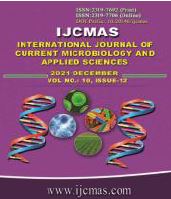


 National Academy of Agricultural Sciences (NAAS)
National Academy of Agricultural Sciences (NAAS)

|
PRINT ISSN : 2319-7692
Online ISSN : 2319-7706 Issues : 12 per year Publisher : Excellent Publishers Email : editorijcmas@gmail.com / submit@ijcmas.com Editor-in-chief: Dr.M.Prakash Index Copernicus ICV 2018: 95.39 NAAS RATING 2020: 5.38 |
Milk yields and their relationships with blood and milk metabolic parameters were assessed in 59 high-yielding Holstein cows over the course of their lactation to identify metabolic constraints to daily milk production. Over an 11 month lactation period the cows, which were milked thrice daily and fed a total mix ration, had a mean daily milk yield of 35.5 l. Blood parameters monitored were haematocrit (PCV), erythrocytes (RBC), leucocytes (WCC), hemoglobin, neutrophils, lymphocytes, monocytes, eosinophils, urea, protein, creatinine, triglycerides, cholesterol, magnesium (Mg), phosphorus (P), calcium (Ca), sodium (Na), potassium (K), chloride (Cl), aspartates aminotransferase (AST), alanine aminotransferase (ALT), alkaline phosphatase (ALP), and glutamic gammatransferase (GGT). Stepwise regression indicated that blood haemoglobin concentration was most closely and positively correlated with milk yield, indicating that oxygen-carrying capacity was potentially a limit to milk production. Secondly, milk Na was negatively correlated with milk yield, and milk protein yield was negatively correlated with milk Mg, Ca and Na, demonstrating lack of homeostatic control of these elements in milk. Principal component analysis identified a primary metabonomic axis of hemoglobin and RBC concentrations at one end and blood K, Na and milk lactose at the other, which appeared related to milk production. A second axis was apparent of milk divalent cations at one end and monovalent cations at the other. It is concluded that constraints to milk production in high yielding cows may exist due to limited oxygen-carrying capacity of the blood, as well as monovalent cations.
 |
 |
 |
 |
 |